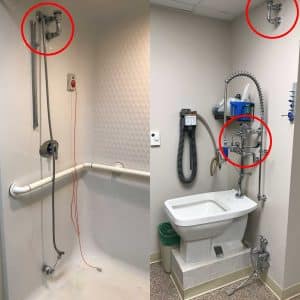By Terry Murphy, HydroCorp

HydroCorp just recently conducted a Facility Risk Assessment for one of the world’s preeminent research hospitals. As always, these surveys remind us that potable water in healthcare facilities is under siege from dozens of threats, including uncontrolled backflow, supply disruptions, or water quality degradation. But you’ll only find them if you know where to look. Which is precisely why we conduct these assessments. In broad terms, we look for cross-connections: any potential for a hazardous substance to enter the potable water supply. And in healthcare facilities, hazardous substances abound.
Here are some examples.
It’s About Isolation
Hospitals and nursing homes exist to care for human beings. And let’s be honest, it is sometimes an indelicate job. There are process fluids and chemicals and other substances involved, none of which anyone would want in their drinking water. So we look for approved vacuum breakers on every sink or shower hose connection in every exam and patient room. We also look for more critical isolation mechanisms like backflow prevention assemblies supplying medical equipment and laboratory functions. And if the facility includes autopsy or morgue services, you can imagine how critical it is to isolate those environments from the potable water system.
Areas of scrutiny include all instances where process (non-potable) water may be allowed to contaminate potable water, through an uncontrolled cross-connection. These include equipment sterilization, dialysis suites, process heat exchangers, hydrotherapy tubs, humidification systems, endoscope reprocessing, deionized water systems, and more.
It’s About Infection
Imagine a hose connection for, let’s say, filling a janitor’s bucket. This hose hasn’t been used in several months, the water in it is stagnant, and a biofilm has formed. But it’s still connected to the plumbing system.In our business, that’s not only a cross connection hazard, but a dead-leg: any portion of a water system where the water remains inert for an extended period…and it’s an ideal breeding ground for pathogens like Legionella. A recent CDC report reveals 33% of Legionellaoutbreaks, 57% of outbreak-associated cases, and 85% of outbreak-associated deaths, are healthcare facility-related. And the majority of those – 79% – originate in nursing and long-term care facilities
The hose connection is a fairly obvious hazard, yet most people would miss it. What about the hazards one can’t see, hiding in the walls or ceilings of a building? A healthcare facility risk assessment – conducted by a qualified cross-connection control expert – will reveal hidden risks to patients, staff, and visitors that the untrained eye would never detect. Risks that, in too many other facilities, have led to sickness, death, and bankruptcy. For CMS-certified healthcare facilities, a risk assessment is mandatory. But for any nursing home or hospital in the country, it’s a fast, efficient, and effective first step in protecting a facility’s water system from unseen dangers.

